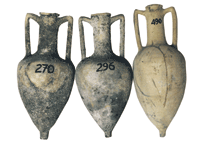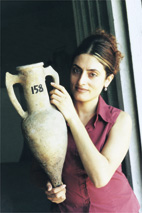|
- COMMERCIAL AMPHORAS OF RHODES ISLAND (BC) - |
||
|
Think of an island which sends its products over seas, by amphoras
and thus having connection with the far away countries such as
Russia, Egytp, India, France and Spain. An island which becomes the
brand name in wine production and then, years later, ten thousands of
amphora handles are found in the city of Alexandria. It is because of that reason I think, when I put a pen on the paper to write about Rhodes commercial amphoras, an inner voice told me, "hang on, Mustafa Aydemir. You are writing about commercial amphoras (in that economical crises), but you never talk about its commercial aspect." "That is right",I thought to myself. It is a good idea to give a few examples about the commerce of thousands of years ago to the people of my country; a country which cannot produce enough, cannot commerce with world countries, loses its vision and thus always struggles with crises. |
|
|
|
|
To make up my mind,I moved my chair from the table. Joining my hands
on my nape, I directed my looks to the ceiling. Where should I
start? From the first painted commercial pots produced in
Burdur, Hacilar in the calcaletical age; from the egg-shaped amphoras
of Troy; from Urartu boilers or from the metal bowls of Frigya with a
central ornament. Or should I start with the copper exportation in Anatolia in compensation with tin impotation? Or should I start with the richest man in the world, Karun, who collected the gold carried by the river Maender with furs and then the first golden money? Or should I start with the Assyrian merchants who used black roller seals on the commercial aggrements writen on plates of clay? |
|
|
Some of
these documents were found at Hattusa State
Archieves. Moreover, besides the offical commerce that was taxable, these merchants sent, on mules, illegal goods to Anatolia from the south-east border and made tax-free, cheap sales. No,no. It will be best to start with the Phoenicians who were great merchants and seamen. Those Phonecians conquered all countries, not by swords, but with trade.They proceeded so much in trade that,by buying and selling goods, they reached the Cape of Hope, in Africa at the south and to England at the north. |
||
|
When they went to a country, first they would present to kings and
rulers of this country,the confidience, friendship and good will
letters from their own king, And then,they would give to those same
people the most persuading bribes, I am sorry, the presents to be
able to trade with them... Besides the commercial collonies they constructed, the Phonecians used deserted islands as bonded warehouses to secure their goods. As it is in Kartaca example, most of these collonies,developing with marketing economy,became big cities. |
|
|
|
|
I do not know what you think,but in my opinion,the old Greek did
better than the Phonecians in trade. Taking the "trade flag" from the Phonecians, the Greek people developed the Phonecian alphabet and adaptated it to themselves and then got the control of the whole Mediterrenean-Black sea trade. These people,spreading out of Greece and Aegean islands,formed collonies everywhere and became trade monopolies of the ancient age. In those ages, the population of the Greek, living at collonies over seas was more than the ones living on the mainland. It is due to the welfare provided by the trade that the Greek people became famous in art, science, techniques and in philosophy. |
|
|
However, what affects me
deeply is the tactics of the Egypt king, Amasis. To draw the foreign capital to his country and to be able to control the taxes,he declared Naukratis city as a free-zone.He gave special facilities to Greek, islandeer and Anatolian merchants and businessmen.As a result of this commercial investments,he endowed so much from the income taxes. The commercial laws and controls of Amasis were so firm that any seaman or merchant delivering goods other than the Naukratis port wolud be executed.This king,also gave land to the foreigners,who do not want to settle down,so that they could build temples for their own gods.For example,the Khios, Teos, Phokai, Klazomenai, Knidos, Halikarnassos, Phaselis, Lesbos and Rhodein people built huge Hellenion temple with their common money. To explain better the commercial philosophy of the old ages,I will give you an example from Rome and finish the subject. The most wandering and the most philosopher Roman emperor who lived in the 2nd century AC.(search for his name if you are curious),said: "The first responsibility of an emperor is to ensure the safety of trade ways and to remove all the obstacles in commerce for the welfare of the community." It is tihs point of view and deeds that enriched the people living on those lands,before us,with production and trade. The most specific example of this is today's ancient cities of anatolia,which witnessed a great improvement in architecture. It is pity that,we,in our present day, could not manage to set up even one city as planned,substructural,as technical and aesthetical as the old ones.Those cities had the biggest theatres,most beautiful baths,most elegant public fountains,streets with big columns,gymna siums and many other works of arts that they could be proud of. It is thought that the first Rhodein amphoras, used in wine exportation,were produced in the 4th century BC. |
||
|
|
Those amphoras were bigger than the serial produced amphoras of the
3rd-2nd centuries BC. Rhodein amphoras were usuallt sealed. In the first amphoras,on one handle,there was the symbol of the producer,on the other handle,there was the symbol of Sun god.These seals were the quarantee of the quality of the wine and it was a means of taxing the exportation. In my collection only 1/3 of those amphoras are sealed. In later periods,the names of the city administrators were included in the seals,too. In fact,the wines of Rhodes were not very famous,but with the importance attached to vine-growing and with marketing and price policy, they were the msot widely sold wines of the Hellenistical age. |
|
|
Rhodes island amphoras were of high quality and were sound due to
the perfect techniques used in furnacing. The islandeers joined the Troyan war, with 9ships, in the 12th century BC. on the side of the Greek.In the 2nd century BC., they gave 4 warships to Rome and allowed the Romans to use the island as a military base, and so made it easier for the Romans to dominate natolia and east-Mediterrenean. |
||
|
The island was so rich to erect the Rhodes Statue, one of the 7
miracles, at the entrance of the port in 305 BC. The statue was the work of Khanes. It was made from bronze. It was 32 metres high and was symbolizing the sun god, Helios.The ancient resources relate that the statue collapsed,78 years after its erection, by an earthquake. The island,becoming rich with wine exportatiion, developed more by being Roman ally and friend. However, the Romans left the control of Likya and Pamfilya to the Rhodiens.With the effect of geographical closeness, the last period Rhodes-Knidos Cos amphoras were influenced from each other. However, in Rhodes amphoras of this period, the handles became pointed. |
|
|





